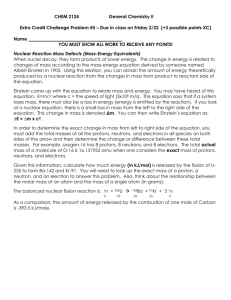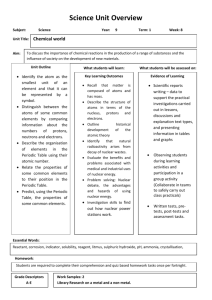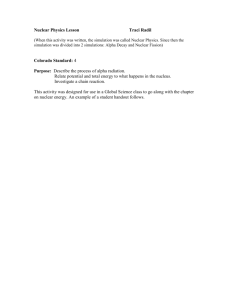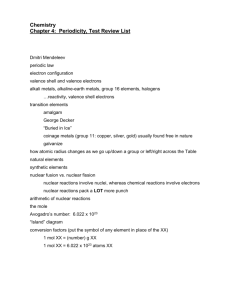Nuclear and Modern Physics
advertisement
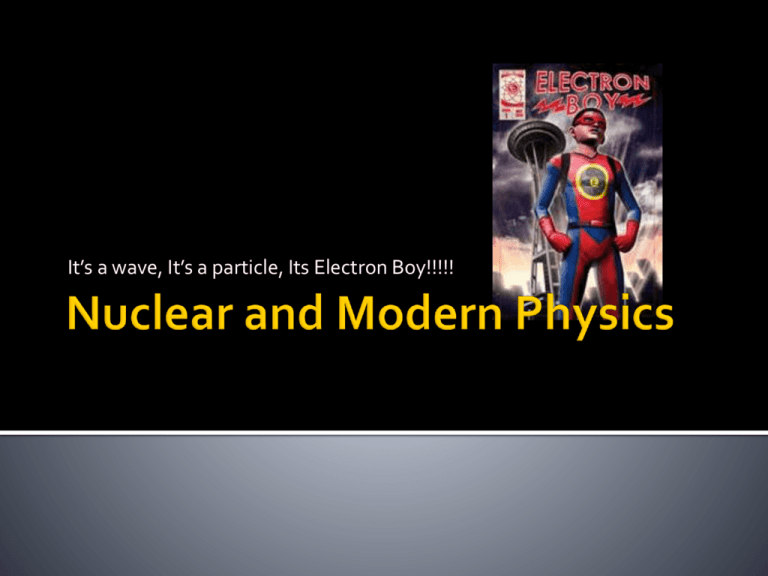
It’s a wave, It’s a particle, Its Electron Boy!!!!! Light emission is understood with the familiar planetary model of the atom. (Bohr’s Model) Each element has a number of electrons that occupy the shells surrounding its nucleus, each element also has its own pattern of electron shells, or energy states. These states are found only at certain energies; we say they are exact, whole. We call these steady states quantum states. When energy is absorbed by an element, an electron may be boosted to a higher energy level. The atom is said to be excited. Later, it returns to its original level. Fluorescence Many materials excited by ultraviolet light emit visible light upon de-excitation. Many substances undergo excitation when illuminated with ultraviolet light. Incandescent lamp A glass enclosure with a filament of tungsten, through which an electric current is passed. The hot filament emits a continuous spectrum, mostly in the infrared, with smaller visible part. The glass enclosure prevents oxygen in air from reaching the filament, to prevent burning up by oxidation. Argon gas with a small amount of a halogen is added to slow the evaporation of tungsten. The efficiency of an incandescent bulb is 10% Fluorescent lamps UV emitted by excited gas strikes phosphor material that emits white light. Compact fluorescent lamps (CFL) Miniaturize a fluorescent tube, wrap it into a coil, and outfit it with the same kind of plug a common incandescent lamp has, and you have a compact fluorescent lamp (CFL). CFLs are more efficient than incandescent lamps, putting out about 10 times more light for the same power input. A downside to the CFL is its mercury content, which poses environmental disposal problems. A photoelectric effect is any effect in which light energy is converted to electricity. Light shining on the negatively charged, photosensitive metal surface liberates electrons. The liberated electrons are attracted to the positive plate and produce a measurable current. Current can be sent out as electrical power or used to run other motors and machines as needed. The photoelectric effect (continued) The photoelectric effect (continued) Light behaves like a wave when it diffracts and refracts. Light behaves like a particle when it knocks other electrons away from certain metals. This is called the Wave - Particle Duality of Light. Scanning Electron Microscope uses the wave nature of electrons to create images similar to the image of the mosquito shown here. A streetlight is a good example of an application of photoconductivity. As daylight fades, the electrical current in the streetlight’s semiconductor stops. This activates a switch that turns the streetlight on. Solar panels are nothing more than a series of metallic plates that face the Sun and exploit the photoelectric effect. The light from the Sun will liberate electrons, which can be used to heat your home, run your lights, or, in sufficient enough quantities, power everything in your home. Source: www.futureenergy.org/ picsolarpannelsmatt.jpg Radioactivity Radioactivity is the process of nuclear decay (radioactive decay). Nothing new in the environment; it’s been going on since time zero. It warms Earth’s interior, is in the air we breathe, and is present in all rocks (some in trace amounts). It is natural. Radioactive elements emit three distinct types of radiation: • —alpha: positively charged (helium nuclei) • — beta: negatively charged (electrons) • —gamma (electromagnetic radiation) • n - neutron Relative penetrations A typical uranium fission reaction: Note the mass number as well as atomic numbers balance. Chain reaction—a self-sustaining reaction in which the products of one reaction event stimulate further reaction events Chain reaction in uranium Small amount, chain reaction fizzles. Critical amount, chain reaction produces an explosion. Nuclear fission reactors About 20% of electric energy in the United States is generated by nuclear fission reactors. More in some other countries— about 75% in France. Reactors are simply nuclear furnaces that boil water to operate steam-driven generators. Nuclear fusion is the opposite of nuclear fission. Fission: nuclei “fizz” apart. Fusion: nuclei fuse together. Typical fusion reactions:



